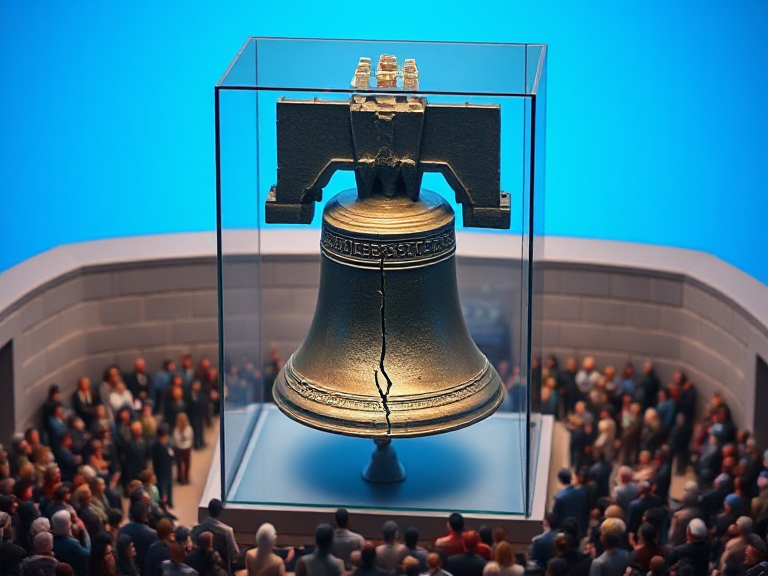Why the Liberty Bell Has a Crack: Fact vs. Fiction
The Liberty Bell, one of the most iconic symbols of American independence, is instantly recognizable due to the famous crack that runs down its side. But why does it have a crack? This blog explores the true history behind the Liberty Bell’s famous defect and separates fact from fiction.
DipVai
1/30/20253 min read


The Liberty Bell stands as a symbol of freedom, democracy, and the enduring spirit of the United States. For many, the crack running down its side is just as iconic as the bell itself. But how did this crack come to be? Was it a defect from the start, or was it the result of an event or accident? The story behind the Liberty Bell's crack is shrouded in mystery, with both historical facts and popular myths surrounding it.
The Bell’s Origins
The Liberty Bell was cast in 1752 in Whitechapel Bell Foundry in London, England. It was ordered by the Pennsylvania Provincial Assembly for the Pennsylvania State House (now known as Independence Hall). The bell was to be used for important events, such as the reading of the public’s declaration of independence. Upon its arrival in Philadelphia, it was discovered that the bell had a noticeable crack in it, which led to it being recast twice by local founders John Pass and John Stow.
Despite this early flaw, the bell was soon used to summon the people of Philadelphia to listen to the reading of the Declaration of Independence on July 8, 1776, though it’s debated whether the bell actually rang that day. Its role in American history began to solidify, and over time, the bell became an enduring symbol of American liberty.
The Famous Crack: Fact vs. Fiction
The crack in the Liberty Bell that we recognize today didn’t appear overnight. It developed gradually, and the story of how it came to be is a mixture of historical facts and myths.
Fact: The Crack Came Later
The crack that is most famously associated with the Liberty Bell actually developed much later in its life. The most widely accepted historical account is that the crack appeared sometime in the early 19th century, around 1817. The bell was used to summon people for various public events, including the commemoration of George Washington’s birthday. Over time, frequent ringing caused a hairline fracture that expanded until it became the crack we recognize today.
Fiction: The Crack Happened on the Bell’s First Ring
One of the most popular myths surrounding the Liberty Bell’s crack is that it occurred on its very first ringing. According to this story, the bell cracked during the first time it was rung to celebrate the signing of the Declaration of Independence. However, historical evidence does not support this claim. As mentioned earlier, the bell had already developed a crack before it was even used for that purpose, and it wasn’t until years later that the prominent crack took shape.
Fact: The Crack Was Likely a Result of Wear and Tear
It’s most likely that the crack appeared gradually over time, caused by the repeated ringing of the bell. Bells are made of a delicate alloy of metals, and their frequent use can lead to stress fractures. The Liberty Bell was used for many significant events, including public celebrations, funerals, and church services. The tolling, particularly over the years, would have eventually led to the cracking of the bell. In fact, the bell was not used regularly for a long time before it became a symbol, and this prolonged exposure to wear and tear eventually caused the damage.
Fiction: The Crack Was a Symbolic Defect
Another myth that has circulated is that the crack was intentionally created to symbolize the nation's struggles and the imperfections of freedom. While the crack undoubtedly came to represent the struggles for liberty and justice, it was not intentionally put there to serve as a metaphor. In fact, the crack was more likely an unfortunate consequence of use than a symbolic gesture.
Interesting Facts About the Liberty Bell
The Crack is 24.5 inches long: The visible crack stretches from the top of the bell to about halfway down its side. It’s estimated to be around 24.5 inches long.
The Bell Weighs Over 2,000 Pounds: Despite its size, the Liberty Bell was cast in a relatively small mold, which is why it has its distinctive shape.
It Was Never Actually Rung on July 4, 1776: There is no evidence to suggest that the bell rang to celebrate the signing of the Declaration of Independence. The bell likely didn’t ring that day at all.
The Bell Is Made of 70% Copper: The bell is primarily made of copper, but it also contains a mixture of tin, lead, zinc, and arsenic.
The Legacy of the Liberty Bell’s Crack
Today, the Liberty Bell is one of the most visited and recognized monuments in the United States. Its crack has become an integral part of its identity, and many people see it as a symbol of the nation's imperfections and its ongoing journey toward achieving true freedom and equality for all its citizens.
While the exact cause of the bell's crack may never be fully known, the historical significance of the bell itself remains unquestionable. Over time, the crack has evolved from a mere defect to a symbol of resilience, representing the challenges and triumphs of the American people.
Get in touch
itsusdipvai@gmail.com
